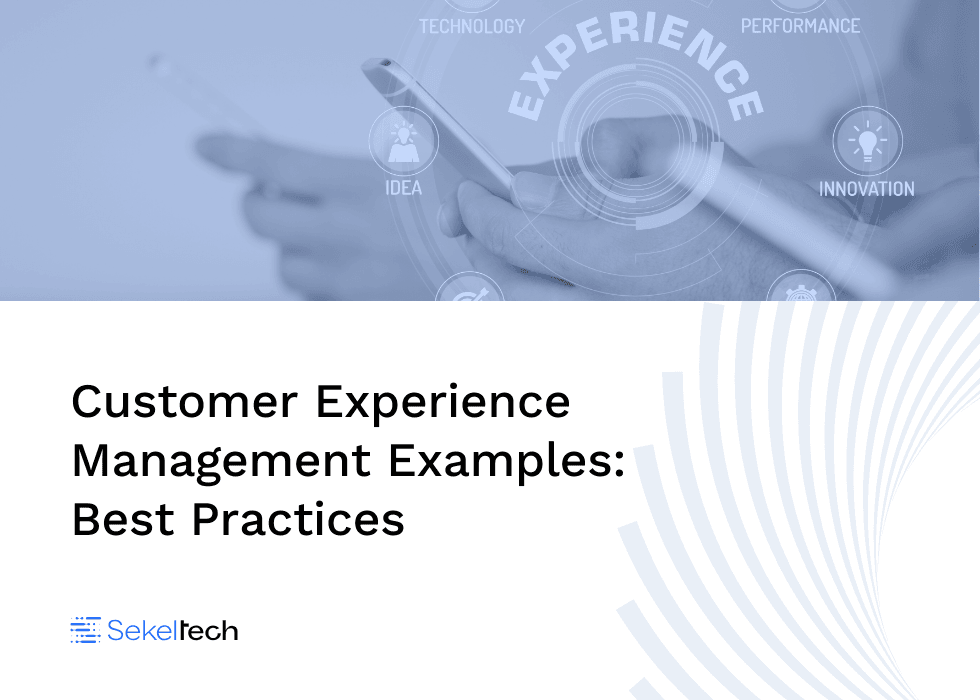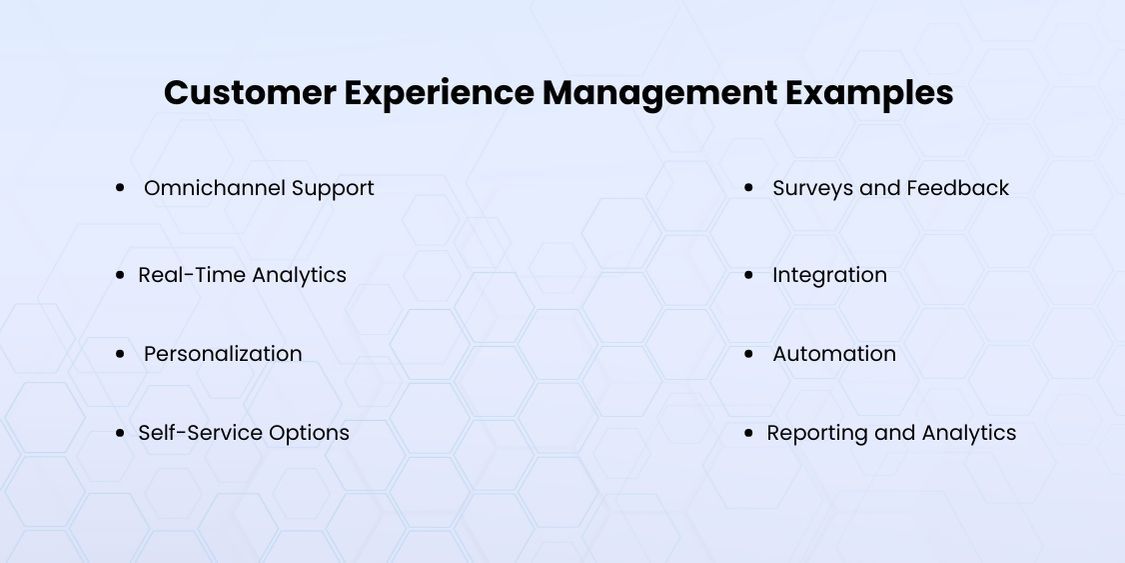Customer Experience Management
Customer Experience Management Examples: Best Practices
Thu, 04 Apr 2024 06:12:46 GMT
Speak to our Hyperlocal Expert

Customer Experience Management examples are applied strategies used by companies to understand how to build powerful online storefronts, implement highly user-friendly technology, increase conversion rates and streamline internal processes effectively.
This helps organisations tailor their services for customers and deliver a superior experience at every stage of the customer lifecycle. Additionally, it allows businesses to identify opportunities for optimization in communication across touchpoints, personalise offerings to customers, monitor levels of satisfaction, and more accurately measure loyalty.
In this article, we will explore some of the best practices and real-world examples of companies that are successfully implementing CEM to drive business growth and improve customer satisfaction. From creating personalised customer experiences to leveraging customer data and feedback, these customer experience management examples demonstrate the power of CEM in action.
Importance of Customer Experience Management
Customer experience management (CEM) is important because it tracks and analyses customer interactions and feedback in order to improve customer satisfaction and loyalty. It is important for businesses to prioritise CEM because it can help increase revenue, improve brand reputation, and reduce customer churn. Additionally, in today's digital age, customers have many options and will often turn to social media and online reviews to share their experiences with others, making it even more important for businesses to actively manage and improve the customer experience.
Customer experience management (CEM) is essential in the modern economy. Companies that focus on improving customer experiences are more likely to drive revenue growth, increase customer loyalty, and gain a competitive edge. Studies have found that CEM can help businesses increase their market share by up to 15%, boost profit margins by up to 20%, and reduce customer churn rate by up to 40%.
Furthermore, customers who have had positive experiences with a company are more likely to recommend it over competitors.
To maximise the benefits of CEM, companies need strategic approaches for understanding customers’ needs and preferences. This includes collecting data from various sources such as surveys and feedback forms; analysing this data; developing targeted strategies based on these insights; implementing changes across processes such as product design or service delivery; and measuring performance against goals set prior to implementation.
By taking this approach towards CEM, organisations can benefit from improved customer satisfaction levels which lead directly into stronger relationships with both existing users as well as potential new ones.
What Attributes Define the Ideal Customer Experience?
Creating an ideal customer experience requires a thoughtful multi-faceted approach to meeting the customer’s needs and expectations. At the forefront of this is a combination of prompt responsiveness, warmth, consistency and comprehensiveness in communication.
It also requires that customers are met with the required level of respect. Companies must further provide self-service tools where possible to allow customers to access what they need easily, clearly and quickly. To ensure a successful customer experience it is important that companies have processes in place that enable employees to be informed on product/service features as well as up-to-date on trends and changes in customer sentiment.
This allows employees to make data driven decisions regarding interactions with the customer while always making the effort to exceed their expectations and maintain loyalty. Lastly, proactively providing value through services such as rewards programs can keep customers engaged over time and demonstrate tangible appreciation for their patronage.
We have classified the attributes of ideal customer experience in the following pointers:-
1. Personalization
Tailoring the experience to the individual customer's needs and preferences. This can include things like recommending products or services based on their past purchases, or addressing them by name when they contact customer service.
2. Convenience
Making it easy for the customer to interact with your business and access the products or services they need. This can include things like offering multiple channels for customer service (e.g. phone, email, chat), or providing online tools for self-service.
3. Consistency
Providing a consistent experience across all channels and touchpoints, including in-store, online, and over the phone. This means that the customer should have the same level of service, branding, and information regardless of how they choose to interact with your business.
4. Transparency
Being open and honest with customers about products, services, and pricing. This means clearly communicating the details of products and services, as well as any associated costs or fees, so that customers can make informed decisions.
5. Responsiveness
Quickly and efficiently addressing customer inquiries and concerns. This means having a system in place to respond to customer inquiries in a timely manner and providing helpful, accurate information.
6. Empathy
Showing understanding and care for the customer's needs and feelings. This means being able to put yourself in the customer's shoes and understanding their perspective, and treating them with respect and kindness.
7. Proactivity
Anticipating customer needs and offering solutions before they are requested. This means being proactive in identifying potential issues or areas of improvement and taking steps to address them before the customer has to ask.
8. Accessibility
Making products, services and customer service available to all customers, including those with disabilities. This means designing products and services that are usable by as many people as possible, and providing customer service in multiple formats (e.g. text, audio, video) to accommodate different needs.
9. Inclusivity
Being inclusive and respectful of all customers, regardless of their background or identity. This means creating a welcoming environment for customers from all backgrounds and treating everyone with dignity and respect.
10. Continual Improvement
Continuously seeking feedback from customers and using it to improve the overall experience. This means regularly gathering customer feedback, analysing it, and making changes to improve the customer experience.
Customer Experience Management Examples

1. Omnichannel Support
Sekel Tech, a hyperlocal marketing agency, that provides solutions for managing retail orders, online and offline consumer journeys, and brand internet presence. Through a single SaaS platform, it offers a variety of user-friendly, rich content development and distribution solutions, bridging the online-offline customer experience and seamlessly integrating the physical and digital worlds.
2. Real-Time Analytics
Amazon, an e-commerce giant, uses real-time analytics to personalise the shopping experience for customers. By analysing browsing and purchase history, Amazon can make product recommendations and offer personalised deals and discounts in real-time.
3. Personalization
Netflix, a streaming service, uses personalization to recommend TV shows and movies to its customers. By analysing viewing history and ratings, Netflix creates a personalised homepage for each user, showing content that is most likely to be of interest.
4. Self-Service Options
Starbucks, a coffee company, has implemented self-service options in their stores. Customers can use a mobile app to order and pay for their drinks, and then pick them up at the store without having to wait in line.
5. Surveys and Feedback
Dell, a computer technology company, uses surveys and feedback to improve their products and services. Dell regularly surveys its customers to gather feedback on product design, customer service, and overall satisfaction.
6. Integration
Hubspot, a marketing, sales and service software company, integrates a variety of tools and platforms to create a seamless experience for their customers. This includes integrating with email, CRM, social media, analytics and more.
7. Automation
Nordstrom, a department store chain, uses automation to streamline their inventory management. They use automated systems to track stock levels and reorder products as needed, ensuring that popular items are always in stock.
8. Reporting and Analytics
Salesforce, a customer relationship management software company, provides reporting and analytics tools to help businesses gain insights into customer behaviour and improve their sales and marketing efforts. Salesforce's analytics platform allows businesses to track key metrics, such as customer lifetime value and lead conversion rates, and make data-driven decisions.
Lastly, customer experience management examples can be extremely useful for businesses looking to improve customer satisfaction and loyalty. By studying and learning from the customer experience management examples and best practices of leading companies, businesses can gain valuable insights and ideas for improving their own CEM efforts. Whether it's through personalization, leveraging customer data, or utilising feedback, the examples provided in this article demonstrate the power of CEM in driving business growth and building lasting customer relationships. By implementing some of these strategies, businesses can improve the overall customer experience and gain a competitive edge in today's marketplace.
Frequently Asked Questions (FAQs)
1. What are 2 important parts of customer experience?
Two important parts of customer experience are customer expectations and customer satisfaction. Customer expectations are shaped by customers' experiences and represent their desired experience when engaging with a company. Customer satisfaction is measured by how closely the actual experience aligns with customer expectations.
2. What are the main elements of customer experience management?
The main elements of customer experience management include understanding customer needs, designing customer-centric experiences, delivering on customer expectations, and measuring customer satisfaction. Understanding customer needs involves researching and analysing customer demographics, interests, and behaviours.
Designing customer-centric experiences involves creating unique and engaging experiences for customers that are tailored to their needs. Delivering on customer expectations involves ensuring that customer experiences are consistent and reliable. Measuring customer satisfaction involves using metrics such as Net Promoter Score and Customer Satisfaction Score to gauge customer satisfaction.
3. What are customer experience skills?
Customer experience skills include empathy, communication, problem-solving, and creativity. Empathy involves understanding customers’ needs and feelings, and being able to relate to them. Communication involves being able to effectively communicate with and understand customers. Problem-solving involves being able to troubleshoot customer issues quickly and efficiently. Creativity involves being able to come up with new and innovative solutions to customer problems.
4. What is the role of customer experience?
The role of customer experience is to ensure that customers have a positive experience when interacting with the company.This involves creating experiences that meet customer expectations as closely as possible, as well as continuously improving customer experiences by incorporating customer feedback.
5. What are 5 parts of the customer experience cycle?
The five parts of the customer experience cycle are discovering customer needs, designing customer experiences, delivering the experience, measuring customer satisfaction, and optimising the experience. Discovering customer needs involves researching and analysing customer demographics, interests, and behaviours. Designing customer experiences involves creating unique and engaging experiences for customers that are tailored to their needs.
Delivering the experience involves ensuring that customer experiences are consistent and reliable. Measuring customer satisfaction involves using metrics such as Net Promoter Score and Customer Satisfaction Score to gauge customer satisfaction. Optimising the experience involves incorporating customer feedback and making changes to continuously improve customer experiences.
Conclusion
In conclusion, customer experience management examples provide insight into the best practices for creating a satisfying customer journey. By understanding each step of the process and emphasising customer feedback, businesses can build meaningful relationships with their customers while improving overall satisfaction and loyalty. As a result, it is essential that companies invest in CX management strategies to ensure they are providing an exceptional buying experience to their customers. If you’re looking to improve your organisation's CX strategy, consider implementing these customer experience management examples today!
Take Advantage of Sekel Tech's Customer Experience Management
The key to creating a positive customer experience is understanding the needs of customers, and then implementing strategies that make their experiences as enjoyable as possible. Sekel Tech's Customer Experience Management system is one of the best in the industry, offering solutions designed to help you acquire data and insights necessary for managing customer relationships. By leveraging CXM capabilities such as segmentation, automation, analytics and more, businesses can improve their reach with target audiences while providing an overall better experience. Take advantage of Sekel Tech’s customer experience management examples to ensure your business offers customers engaging interactions and smooth transactions each time they interact with your brand.
Share
Similar Blogs
Loved this content?
Sign up for our newsletter and get the latest tips & updates directly in your inbox.
There’s more where that came from!